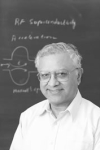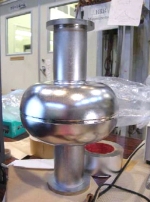Director's Corner
22 March 2007
 Barry Barish |
ILC Baseline Alternative: The Re-entrant Cavity
 Hasan Padamsee, leader of the Cornell superconducting RF R&D group |
ILC R&D on superconducting RF technology is of special importance because it represents our central technology, and it is an area where we are forging the way for future accelerators that will employ this forward-looking technology. In addition to the high-priority demonstrations of the achievable gradient for our baseline TESLA-shape cavities, we are pursuing a broad R&D programme on alternatives that should lead to improved cavities. Our programme includes work on single crystals, on large grain materials and on alternative shapes to the baseline. One such alternate shape is the re-entrant cavity that promises higher gradients than the TESLA cavities. In fact, two different new shapes have already achieved higher gradients in early, mostly single-cell tests. Although it will take time to develop these alternative shapes to the point where we can produce 9-cell cavities, we fully expect this will be feasible by the time we are ready to upgrade the ILC to 1 TeV, if not before.
Optimising the cavity shape and fabrication processes for high-gradient cavities turns out to be very complicated. Therefore we have supported a vigorous programme on this subject, and this past week our ILC R&D has chalked up another impressive milestone! Hasan Padamsee announced that, in collaboration with KEK, his group at Cornell has achieved a new world-record accelerating field of Eacc = 57 - 59 MV/m for a single cell superconducting niobium cavity.
 The Q vs E curve for the record setting re-entrant single cell cavity.5 |
 Single cell niobium re-entrant cavity. |
Padamsee reports that for the new test on a small aperture re-entrant cavity, the cavity was post-purified it with titanium and then sent to KEK. At KEK they did tumbling, electropolishing, high pressure rinsing and baking. After this treatment, the cavity it could reach 45 MV/m with significant field emission due to the water at the available rinsing facility. After the cavity was returned to Cornell it was subjected to an ultrasonic hot soap and water rinse for 30 minutes (as suggested by recent JLAB successes), followed by a 2-hour high pressure rinse. After this treatment, the cavity reached 59 MV/m as a best result with the Q > 1010 up to about Eacc = 52 MV/m, and it then falls to 5x109 at 56 MV/m.
In practice, the theoretical limit on accelerating cavity performance depends on the amount of magnetic fields that can be sustained on the cavity surface. This limit can be extended by shaping the cavity to reduce the ratio between the peak magnetic field and the electric accelerating field. The re-entrant cavity shape with small aperture reduces the surface magnetic field by about 15% at the cost of increasing the surface electric field, which is a more manageable problem. The new test is for a cavity with a 60 mm cavity aperture, compared to 70 mm for the TESLA cavities and earlier re-entrant shapes. The downside of the smaller aperture is increased wakefields. So in the end a balance will need to be found between maximising the accelerating field and maintaining tolerable surface magnetic fields and wakefields.
We applaud the continuing advances in superconducting RF technology that are being achieved through the ILC R&D program. The coordinated worldwide programme and collaborations are proving to be a real asset in quickly bringing together the developments and advances in different laboratories. This latest achievement for the re-entrant cavity is one of many recent advances in our core technology. Congratulations to all involved!
-- Barry Barish